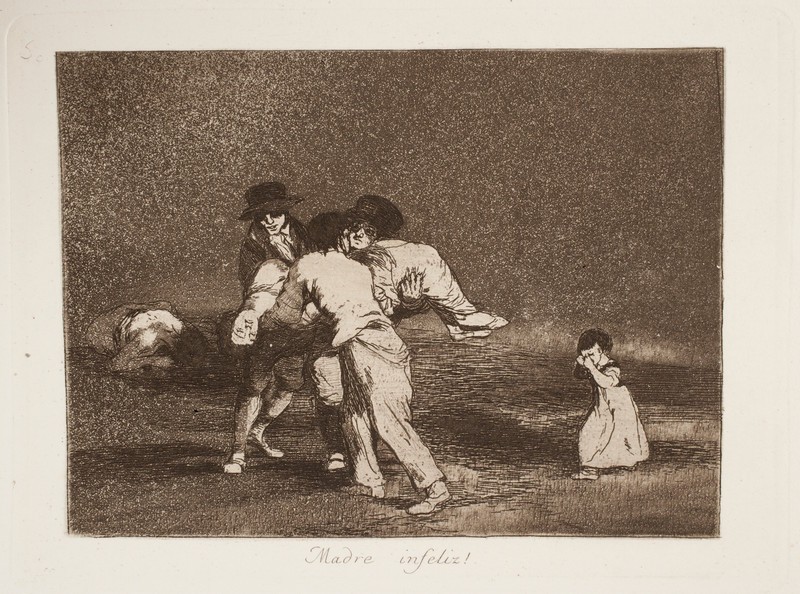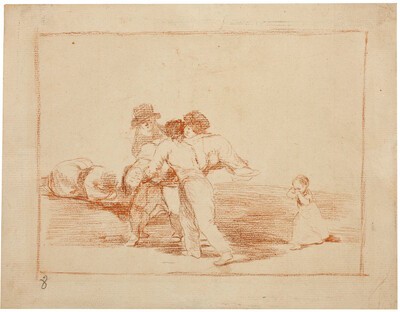- Cronología
- Ca. 1812 - 1815
- Dimensiones
- 157 x 206 mm
- Técnica y soporte
- Etching, burnished aquatint and drypoint
- Reconocimiento de la autoría de Goya
- Undisputed work
- Ficha: realización/revisión
- 15 Dec 2010 / 24 May 2023
- Inventario
- 225
See Sad presentiments of what must come to pass.
The title was handwritten on the print by Goya in the first and only series that is known to have been printed at the time the works were created, which the artist gave to his friend Agustín Ceán Bermúdez. Therefore, the title was etched into the plate at a later date and left unchanged as of the first edition of the Disasters of War printed by the San Fernando Royal Academy of Fine Arts in Madrid in 1863, after the printing of the series in the possession of Ceán Bermúdez.
There is a surviving preparatory drawing for this print which is housed in the Prado Museum in Madrid.
Two men are shown carrying the body of a woman who may have fainted from hunger. Next to these figures a child cries inconsolably, covering her face with her hands. In the background we can see a body on the ground, perhaps the corpse of a victim of the famine.
Goya uses aquatint for the sky and part of the ground: it is difficult to tell where one ends and the other begins. The device creates an unreal, misty setting that heightens the drama of the scene. There are no spatial references in the work, although judging from the darkness it is likely that the scene takes place at night. The artist has placed three points of light in the middle of this darkness: one larger, light area in the centre of the composition comprising the men carrying the woman; another smaller one situated on the right, representing the small child crying, separated from her mother; and the last area of light in the background on the right, highlighting the abandoned corpse.
La plancha se conserva en la Calcografía Nacional (cat. 301).
-
GoyaMinistry of Foreing AffairsBurdeos1951organized by the Bordeaux City Hall, consultant editor Gilberte Martin-Méry. From May 16th to June 30th 1951p. 73, cat. 8
-
Goya. Drawings, Etchings and LithographsGoya. DrawingsLondon1954from June 12th to July 25th 1954pp. 8-10, cat. 64
-
Goya. Das Zeitalter der Revolucionen. Kunst um 1800 (1980 – 1981)Hamburger KunsthalleHamburg1980cat. 91
-
Francisco de GoyaMuseo d'Arte ModernaLugano1996exhibition celebrated from September 22nd to November 17th.p. 167, cat. 50
-
Francisco Goya. Sein leben im spiegel der graphik. Fuendetodos 1746-1828 Bordeaux. 1746-1996Galerie KornfeldBern1996from November 21st 1996 to January 1997cat. 134
-
Francisco Goya. Capricci, follie e disastri della guerraSan Donato Milanese2000Opere grafiche della Fondazione Antonio Mazzottacat. 130
-
Goya. Opera graficaPinacoteca del Castello di San GiorgioLegnano2006exhibition celebrated from December 16th 2006 to April 1st 2007p. 76
-
Goya en tiempos de guerraMuseo Nacional del PradoMadrid2008consultant editor Manuela B. Mena Marqués, from April 14th to July 13th 2008cat. 109
-
Goya et la modernitéPinacothèque de ParisParís2013from October 11st 2013 to March 16th 2014cat. 89
-
Madrid2017
-
Hamburg2019cat. 104
-
2022
-
Goya, grabadorMadridBlass S.A.1918cat. 152
-
Goya engravings and lithographs, vol. I y II.OxfordBruno Cassirer1964cat. 170
-
Vie et ouvre de Francisco de GoyaParísOffice du livre1970cat. 1074
-
Catálogo de las estampas de Goya en la Biblioteca NacionalMadridMinisterio de Educación y Cultura, Biblioteca Nacional1996cat. 259
-
El Libro de los Desastres de la GuerraMadridMuseo del Prado2000II, pp. 98-100
-
ParísPinacoteca de París2013p. 144
-
Goya. In the Norton Simon MuseumPasadenaNorton Simon Museum2016pp. 114-151
-
ZaragozaGobierno de Aragón y Fundación Bancaria Ibercaja2017p. 245
-
HamburgHirmer2019p. 313
-
Museo de Bellas Artes de Badajoz y Diputación de Badajoz2022p. 71

